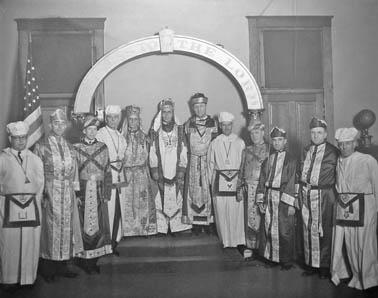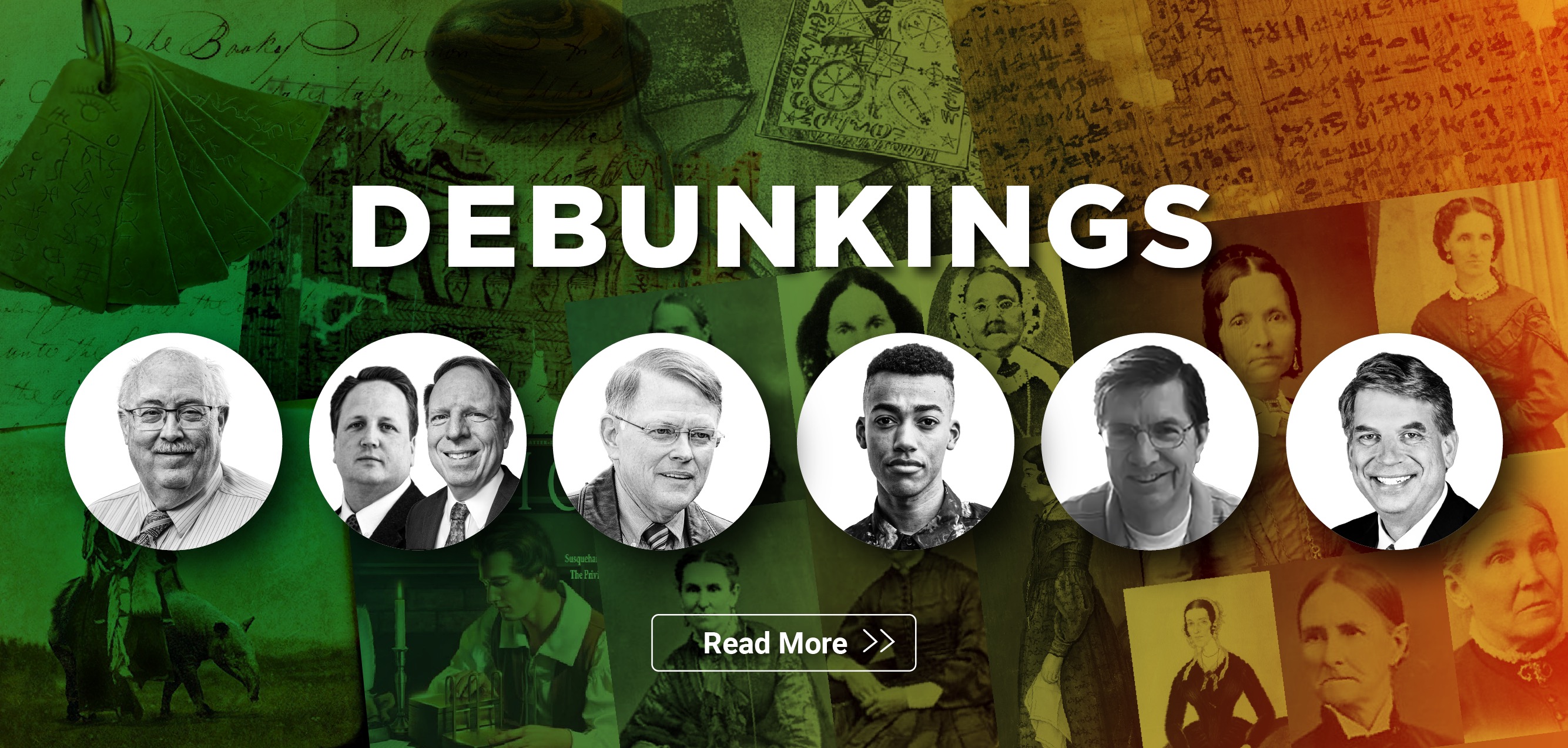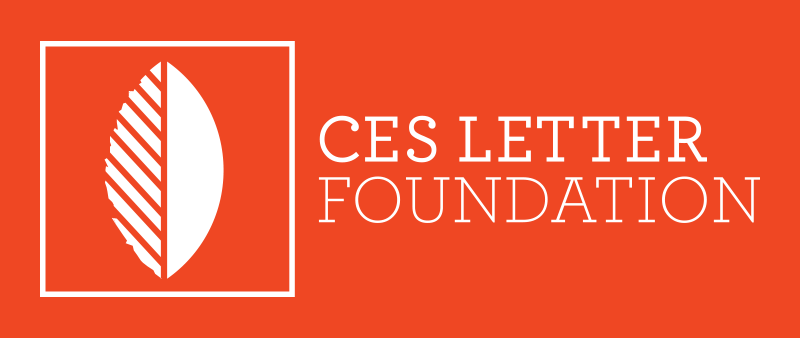Detailed Response
Temples & Freemasonry
Baseline & Foundation
SHORT ANSWER:
There’s nothing sinister about Masonic influence in Latter-day Saint temple ceremonies, and these ordinances will be performed for the entirety of the human family, making the temple universally inclusive.
Jeremy's Response
This is a strawman. I'm not saying it's "sinister" and I do not use that word in the CES Letter or in my writings. It's not a claim that I'm making here.
I'm asking about the origins of the LDS Temple Endowment ceremony itself and whether it's divinely created/restored by revelation or if it's a man-made remix inspired by and influenced by Freemasonry.
I disagree with Jim. The Freemasonry/LDS Temple connection is not a nothingburger like Jim is trying to sell to all of us here. Before we get into the weeds here, it's important to lay out a baseline and foundation here:
Baseline #1: "not to be altered or changed"
Here's what Joseph Smith taught about ordinances and the the nature of ordinances:
"The Prophet Joseph Smith taught, 'Ordinances instituted in the heavens before the foundation of the world, in the priesthood, for the salvation of men, are not to be altered or changed.'" – Ensign, August 2001, p.22
Here's a screenshot from the August 2001 Ensign:
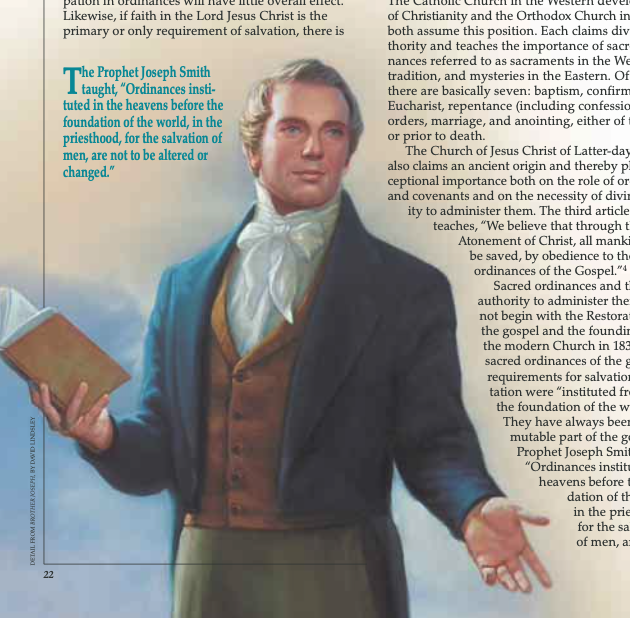
What does "ordinance" mean? The LDS Church's own definition: "Sacred rites and ceremonies." The LDS Church defines the LDS Temple Endowment as an ordinance.
Okay...with me so far? An ordinance is a sacred rite or ceremony and Joseph said that ordinances were instituted in the heavens before the foundation of the world (divine) and they are "not to be altered or changed" (unchangeable).
With Baseline #1 laid down here, let's move over to baseline #2.
Baseline #2: "key words, signs and tokens"
Here's what the Prophet Brigham Young said of the endowment:
"Let me give you a definition in brief. Your endowment is, to receive all those ordinances in the house of the Lord, which are necessary for you, after you have departed this life, to enable you to walk back to the presence of the Father, passing the angels who stand as sentinels, being enabled to give them the key words, the signs and tokens, pertaining to the holy Priesthood, and gain your eternal exaltation in spite of earth and hell."
So, Baseline #2: The purpose of the endowment is to receive the key words, the signs and tokens to return back to the presence of the Father and "gain your eternal exaltation".
Baseline #3: Freemasonry is neither divine or ancient
I agree with Jim Bennett and FAIR that Freemasonry is neither divine or ancient. Further, I agree that Freemasonry has no connection to Solomon's Temple and that Freemasonry has its origins to stone tradesmen in medieval Europe - not in 950 BC Jerusalem.
Now that we have this solid baseline and foundation laid out and set up, we can get into the weeds with Jim's obfuscations to see the weaknesses of his rebuttals and Jim Bennett Mormonism® spin of the problems.
7 weeks after Joseph's Masonic initiation
Just seven weeks after Joseph’s Masonic initiation, Joseph introduced the LDS endowment ceremony in May 1842.
While there are elements of the temple ceremony that demonstrably precede Joseph initiation into Masonry – chunks of the Book of Moses are in the endowment ceremony, for instance – I think you’re absolutely right not to chalk this up to coincidence. The pattern Joseph set was that events served as catalysts for seeking revelation. Remember, the Word of Wisdom came as the result of Emma getting tired of cleaning up tobacco stains. The revelation on plural marriage came after Joseph asked a question in the course of translating the KJV. Answers from heaven are received only after someone asks.
Since revelation doesn’t come in a vacuum, my guess is that Joseph sensed something ancient in the Masonic ceremony and asked about it, which led to the endowment. I don’t think there’s anything sinister in acknowledging the likely connection.
Jeremy's Response
Well, that was easy.
Jim and I agree that "just seven weeks after Joseph's Masonic initiation, Joseph introduced the LDS endowment ceremony in May 1842." Jim and I also agree that there's a connection and that it's not a coincidence.
Where Jim and I go our separate ways is that Jim believes this was simply a catalyst for revelation that led to the LDS endowment. I believe there was no revelation involved as I point to all of the problems below.
"We have the real thing"
President Heber C. Kimball, a Mason himself and a member of the First Presidency for 21 years, made the following statement:
“We have the true Masonry. The Masonry of today is received from the apostasy which took place in the days of Solomon, and David. They have now and then a thing that is correct, but we have the real thing.”
– Heber C. Kimball and Family: The Nauvoo Years, Stanley B. Kimball, p.458
Sure. In other words, the Masons have some ancient practices – “now and then a thing is correct – mixed in with apostate corruptions, and the endowment represents the truth of what masonry should be.
Jeremy's Response
Jim's response here is misleading. Below in Freemasonry originates from medieval Europe, Jim agrees that Freemasonry has its origins to stone tradesmen in medieval Europe - not in 950 BC Jerusalem. Jim writes that Freemasonry "was attempting to mimic the rituals of what happened in 950 BC Jerusalem."
Medieval is not ancient. "Attempting to mimic rituals that happened in 950 BC" is not ancient.
Freemasonry does not have anything to do with Solomon's temple. There's nothing divine about Freemasonry. FAIR agrees: "Nothing is divine about Freemasonry and indeed Freemasonry has rejected any and all attempts to portray it as a religion."
Why is Jim pointing to a non-divine, non-revealed, medieval times, non-ancient, man-made organization (Freemasonry) while claiming that the divinely inspired LDS endowment that was restored by God himself represents a better and "truer" version of it?
Anyway, back to the above Kimball quote. Further quotes suggest that even Joseph Smith believed in the connections of Masonry to the Priesthood. In a June 17, 1842 letter to Parley P. Pratt, Heber C. Kimball wrote:
There is a similarity of priesthood in Masonry. Bro[ther] Joseph says Masonry was taken from priesthood but has become degenerated, but many things are perfect.
–Temples of the Ancient World, p.577
Benjamin F. Johnson, a friend of Joseph Smith, wrote:
He [Joseph Smith] told me Freemasonry, as at present, was the apostate endowments, as sectarian religion was the apostate religion.
–Johnson, My Life’s Review, p.96
Finally, this was not just a 19th-century belief. This was being taught to members in the 20th-century by prophets, seers, and revelators. Elder Melvin J. Ballard (Apostle M. Russell Ballard’s grandfather) taught in the October 1913 General Conference:
What is masonry? Why, a fragment of the old truth coming down perhaps from Solomon’s temple of ancient days, and but a fragment, as Christianity is but a fragment of the Gospel of the Lord Jesus Christ.
–Conference Report, October 1913, p.126-127
"Restored" endowment looks more like apostatized Masonry
If Masonry had the original Temple ceremony but became distorted over time, why doesn’t the LDS ceremony more closely resemble an earlier form of Masonry, which would be more correct rather than the exact version that Joseph Smith was exposed to in his March 1842 Nauvoo, Illinois initiation?
Two things. One, you’re frankly acknowledging here that the Mormon endowment ceremony is different enough from Masonry to be its own thing and not just a pale copy of Masonic ritual, which is the accusation that most critics of the Church make. Second, why should an earlier form of Masonry be more correct? The rituals of Solomon’s temple preceded Masonry by thousands of years. Whatever changes modern Masons have made to their ceremony took place over a relatively short period of time in comparison, so they would be unlikely to have any bearing on whatever portion of truth survived the intervening millennia between Solomon and the Masons.
You’re making assumptions again and not recognizing that you’re likely to be proceeding from a flawed premise.
Jeremy's Response
Based on Jim's response, Jim doesn't understand what I wrote. Either that or he's misrepresenting and mischaracterizing what I wrote and what I'm asking.
I'm not making any assumptions nor am I operating from a flawed premise. This is just Jim not addressing the actual question that I'm asking.
From the box answer below, Jim and I agree that Freemasonry has its origins to stone tradesmen in medieval Europe - not in 950 BC Jerusalem.
And from this box answer, I demonstrate how the early Mormon Freemasons believed that the Freemasonry of their day was the apostatized and corrupted version and that Joseph had restored the true and pure version through modern-day revelation.
If, as the early Mormon Freemasons like Heber C. Kimball, believed that the endowment was a restoration of the true and pure version, why did it resemble more of 19th-century Illinois Masonry instead of the original and true pre-corrupt version?
Freemasonry has zero links to Solomon’s Temple
Freemasonry has zero links to Solomon’s Temple.
Define “links.” You would be correct to say that it’s impossible to demonstrate that the rituals of Masonry have been handed down from the time of Solomon in an unbroken chain. You would be incorrect to say that Masons have not appropriated their understanding of ancient practices into their ceremony. The “link,” then, would not be a passed-down line of authority but one of similar ideas, many of which the Masons undoubtedly got wrong but a few, apparently, they got right.
Jeremy's Response
See Freemasonry originates from medieval Europe box answer below.
"Passed down" myth
Although more a Church folklore, with origins from comments made by early Mormon Masons such as Heber C. Kimball, than being Church doctrine, it’s a myth that the endowment ceremony has its origins from Solomon’s Temple or that Freemasonry passed down parts of the endowment over the centuries from Solomon’s Temple.
The Church makes no attempt to claim that either Freemasonry or the endowment claim their authority from being “passed down” in an unbroken chain from Solomon’s temple.
By way of comparison, the Roman Catholic Church claims their priesthood authority through apostolic succession, while the Mormons claim that their priesthood authority was restored after a long period of apostasy. So while one group claims to have their authority passed down in an unbroken chain while the other claims it was lost and then restored, both groups agree that there is such a thing as priesthood authority, and that there was such a thing as priesthood authority anciently.
Similarly, our authority to perform the endowment ceremony and sealing ordinances does not come from a claim of “masonic succession,” so to speak. While many, including me, believe that what we do now in temples bears a resemblance to what they did anciently – although we don’t know the extent of that resemblance – our authority to perform these ordinances came by means of modern revelation, not from being passed down.
Jeremy's Response

Solomon's Temple...all about animal sacrifice
Solomon’s Temple was all about animal sacrifice.
Oh, nonsense. Solomon’s temple had a whole lot more going on than just animal sacrifice. If you doubt me, then consult the infallible Wikipedia:
Jeremy's Response
This one made me laugh. I'll offer you something better than "infallible Wikipedia", Jim. I offer you prominent Mormon apologist and BYU professor William Hamblin at the 2007 FAIR Conference:
The primary thing was done at these places [temples/tabernacles including Solomon's Temple] was sacrifice. Sacrifice, blood sacrifice at least, is a little unfamiliar to us but sacrifice as a concept is something that is very familiar to us as Latter-Day Saints as a form of worship of our God.
Why do we care more about what Professor Hamblin has to say about Solomon's Temple over Jim Bennett's opinion? Well, Professor Hamblin wrote a book titled...Solomon's Temple: Myth and History. I think it's pretty safe to say that Professor Hamblin did way more research on this topic than you ever did, Jim.
Here's a quote from FAIR:
“Unfortunately, there is no historical evidence to support a continuous functioning line from Solomon’s Temple to the present. We know what went on in Solomon’s Temple; it’s the ritualistic slaughter of animals.”
– The Message and the Messenger: Latter-day Saints and Freemasonry
Jim attempted to undermine and debunk the above quote but I debunk Jim's attempts here instead.
Jim is wrong about Solomon's Temple. Solomon's Temple was primarily about blood/animal sacrifice.
If Jim still doesn't like other apologists and FAIR debunking his uninformed and unsupported opinion, here's "infallible Wikipedia":
"Sacred prostitution": I'm sorry, Jim, but I apparently forgot to include sexual prostitution in the list of services offered at the temple. Guess you're right that there was "a whole lot more going on" there. On a serious note, did you even read the source you linked us to? It's right there in the Worship section. Cringe.
But yeah, right there in the "Worship" section is a big fat bolded header titled, you guessed it, "Sacrifice". In this section, it lists "korban". Let's see some cool quotes on the "Korban" Wiki page:
"After the destruction of the Second Temple, sacrifices were prohibited because there was no longer a Temple, the only place allowed by halakha for sacrifices."
"When sacrifices were offered in ancient times, they were offered as a fulfillment of Biblical commandments. Since there is no longer a Temple, modern religious Jews instead pray or give tzedakah instead to atone for their sins as the korbon would have accomplished. According to Orthodox Judaism, the coming of the messiah will not remove the requirement to keep the 613 commandments, and when the Temple is rebuilt, sacrifices will be offered again."
Like your Jehovah's Witnesses attack, you're talking down to the wrong person, Jim. I'm very familiar with Judaism. I've been to Israel. I studied there. I've been around Jews my entire mission in New York City. In fact, my missionary roommate was Israeli Joshua Rona, whose family is famous in Mormonism for being both Jewish and Mormon and who operate the popular Israel Revealed LDS tours in Israel. My dad lives in Panama half of the year in a beach resort where 90% of the residents are Jewish. I was just down there a few months ago and had Shabbat dinner in Panama City with a Jewish family who are our dear friends and neighbors.
Freemasonry originates from medieval Europe
Freemasonry has its origins to stone tradesmen in medieval Europe – not in 950 BC Jerusalem.
True, although Freemasonry was attempting to mimic the rituals of what happened in 950 BC Jerusalem.
Jeremy's Response
My statement stands correct.
Who cares if they "attempted to mimic the rituals"? There's zero connection between Freemasonry and Solomon's Temple as Freemasonry's origins are in medieval Europe - not 950 BC.
No continuous line from Solomon's Temple
FairMormon admits these facts:
“Unfortunately, there is no historical evidence to support a continuous functioning line from Solomon’s Temple to the present. We know what went on in Solomon’s Temple; it’s the ritualistic slaughter of animals.”
– The Message and the Messenger: Latter-day Saints and Freemasonry
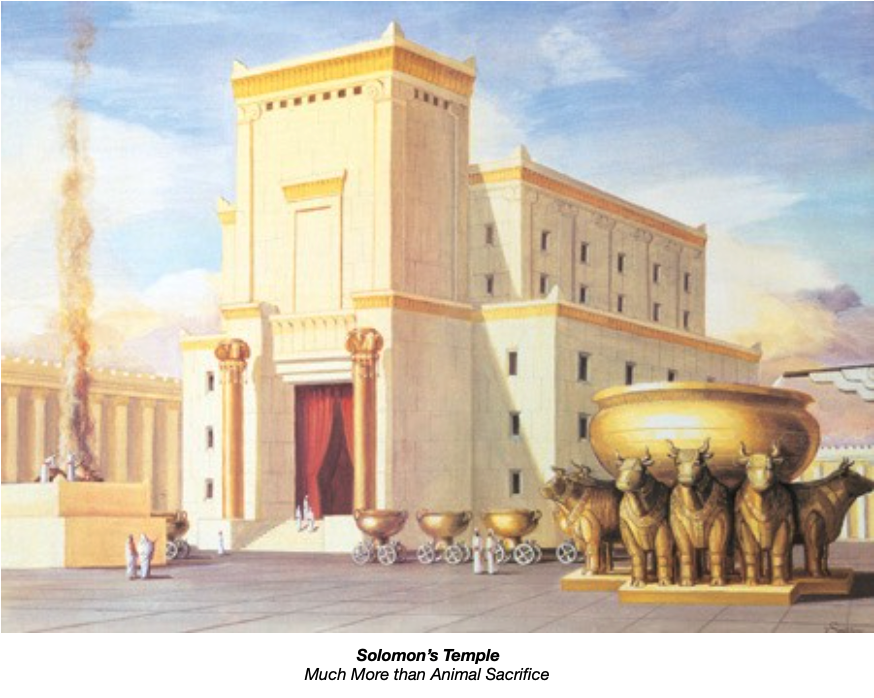
It’s rather misleading to say that “FairMormon admits these facts,” as this is an article that is solely the responsibility of its author, not of FairMormon as a whole, and it’s certainly not the official position of the Church. The writer, a man named Greg Kearney, is both a Latter-day Saint and a Mason, so he’s got an interesting perspective, but he makes no claims of being a scholar, and he is mistaken about Solomon’s Temple, which included much more than the ritualistic slaughter of animals.
That said, it’s a fascinating article, and it offers an interesting perspective on the relationship between temple rituals and Masonry that I had never considered before:
I draw a bright line between the temple endowment and the temple ritual.
The endowment is revealed doctrine necessary for the salvation of the Saints. It teaches us God’s relationship to man; our duties and our responsibilities. The endowment has never changed and if you think about it, what the endowment is are commitments to the law of sacrifice, to the law of consecration, to the law of chastity. These things are fixed and these things can be found throughout every dispensation of time. That is the endowment.
It’s revelatory in nature and content, it’s a restorationist view of religion, it offers universal salvation–Latter-day Saints are Universalists as I always say which always makes everybody shudder.
So we have the endowment and then we have the messenger: the ritual. How the endowment is taught and this is where I believe Masonry played a part. Joseph Smith sat in Lodge, he watched as humble farmers–most of whom he knew probably couldn’t read and write well–learned complicated, difficult ritual and he said in his mind, ‘Ah! This is how I’ll do it. This is how I’ll teach the endowment to the Saints.’ Why? Because they already knew the ritual. They wouldn’t pay attention to the ritual; they’d pay attention to the message because they already knew the ritual. And so, there is that kind of genesis, that ritualistic form, that asking of questions back and forth that we get. All of that comes as Joseph Smith tries to communicate these truths.
I think this is brilliant, and it encapsulates the core of the endowment’s relationship with masonry. The ritualistic structure is similar to Masonry, but the message of what is being taught by the ritual is not. The message of the endowment is the only thing that matters, and the ritual can be altered, or even abandoned, if it’s no longer helpful or necessary.
Jeremy's Response
Bullshit, Jim. What's misleading here is you misleading us about FairMormon and the validity of this quote.
Jim tries to wiggle out of this quote by pretending to be a lawyer talking all lawyerly. Jim's wrong because it's on FairMormon's website. There's zero disclaimer on the article itself or the 2005 FairMormon Conference page or the main FairMormon's Conference page stating anything close to resembling what Jim is making up here. FairMormon's own footer legal disclaimer debunks Jim:
"Any opinions expressed, implied or included in or with the goods and services offered by FAIR are solely those of FAIR..."

My statement and quote stands correct as-is. It's Jim's made up claims that is misleading.
This is actually hilarious because in the Jim Bennett Introduction section, Jim mocks and belittles me for not taking FairMormon seriously because they're "unofficial" and yet here we see Jim criticizing me for believing FairMormon when, as Jim says, content on FairMormon's own website is "certainly not the official position of the Church."
Moving on, Jim thinks his own personal opinion on Solomon's Temple is the only true and correct one and he proceeds to throw shade on Greg Kearney because Greg "is not a scholar" (neither is Jim Bennett so why are we entertaining what he has to say based on this argument?). Nevermind that FairMormon invited Greg to give a presentation...about Temples...from a Masonic perspective. I would trust Greg's opinion about Solomon's Temple over yours, Jim. Sorry but not sorry.
Jim is wrong about Solomon's Temple. Solomon's Temple was primarily about sacrifice. Oh, look...prominent Mormon apologist William Hamblin at the 2007 FAIR Conference:
The primary thing was done at these places [temples/tabernacles including Solomon's Temple] was sacrifice. Sacrifice, blood sacrifice at least, is a little unfamiliar to us but sacrifice as a concept is something that is very familiar to us as Latter-Day Saints as a form of worship of our God.
Why do we care more about what Hamblin has to say about Solomon's Temple over Jim Bennett's opinion? Well, Hamblin wrote a book titled...Solomon's Temple: Myth and History. I think it's pretty safe to say that Hamblin did way more research on this topic than you ever did, Jim.
Masonry can only be traced to medieval tradesmen
FairMormon admits these facts:
“Masonry, while claiming a root in antiquity, can only be reliably traced to medieval stone tradesmen.”
– Similarities Between Masonic and Mormon Temple Ritual
The sentence directly preceding this one provides helpful context: “Many of the Masonic symbols to which Mr. Norton refers pre-date Freemasonry by thousands of years.” In other words, there are ancient elements incorporated into Masonry, and many of those same elements are in the Latter-day Saint temple ritual. That does not mean that Masonry has been an unbroken tradition since antiquity.
This is another excellent article by Greg Kearney, and it includes another great summary of the connection between Latter-day Saint temples and Masonic tradition:
...the endowment ritual has undergone many changes over the years. The ritual is changed to meet the needs of members and to better communicate the endowment to them. Remember, there is a difference between the endowment ritual and the endowment itself. The ritual is not the endowment, but how the endowment is taught–in much the same way that the Catholic Mass is not Holy Communion but how Holy Communion is given to the congregation.
When Joseph was first trying to communicate the truths of the endowment he used a ritual form familiar to the saints of his day. That ritual form was, in some respects, Masonic in nature. As the saints lost their connection to Masonry the symbolic meaning of the penalties and other Masonic elements was lost as well. They became meaningless to all but a few Latter-day Saint Freemasons. So the penalties were removed along with other elements both Masonic and non-Masonic which no longer served the purpose of communicating the truths of the endowment.
Jeremy's Response
The above CES Letter statement stands correct.
All of the above apologetics are contradicted by Joseph Smith's own teachings and claims of modern-day revelation about the Temple Endowment, which is an ordinance:
"The Prophet Joseph Smith taught, 'Ordinances instituted in the heavens before the foundation of the world, in the priesthood, for the salvation of men, are not to be altered or changed.'" – Ensign, August 2001, p.22

Clear that Freemasonry played role in creation of endowment
FairMormon admits these facts:
“It is clear that Freemasonry and its traditions played a role in the development of the endowment ritual...”
– Similarities Between Masonic and Mormon Temple Ritual
“It is clear that Freemasonry and its traditions played a role in the development of the endowment ritual.”
– Similarities Between Masonic and Mormon Temple Ritual
Context, please. If you’re going to use this quote, you have a responsibility to at least use the whole sentence:
“It is clear that Freemasonry and its traditions played a role in the development of the endowment ritual but not the degree that Mr. Norton would like to suggest.” [Emphasis added.]
The whole paragraph is helpful, actually, as it’s clear that Kearney is making a point directly opposite to the one you’re trying to make with his words :
It is clear that Freemasonry and its traditions played a role in the development of the endowment ritual but not the degree that Mr. Norton would like to suggest. Further he also brings up only similarities not the differences between the two. For example the central story in the endowment is the allegory of Adam and Eve. In Masonry it is the story of the master builder of Solomon’s temple Hiram Abiff. Whole vast sections of the Masonic ritual are not and have never been found in the temple endowment.
The simple fact is that no one ever received their endowment in a Masonic lodge and no one has ever been made a Mason in an LDS temple. As a LDS Freemason I find the similarities reassuring rather than disturbing.
Jeremy's Response
"cOnTeXt, pLeAsE"? How about you not bastardize, misrepresent and mischaracterize my quote instead, Jim?
Look at how Jim closes my quote. He just ends it with a period whereas in the CES Letter, I have the "..." ellipsis to clearly show my readers that it's not the complete sentence. Jim's little period stunt is incredibly dishonest and deceptive as it's misleading Jim's readers by giving them the false impression that I'm being deliberately deceptive by trying to pretend my quote is the complete sentence.
My quote stands correct. The only point I'm making here is that "Freemasonry and its traditions played a role in the development of the endowment ritual". Who cares about the "degree" that Mr. Norton would like to suggest? Whether it's 90% degree or 25% degree...the central and main point that Kearney makes and concedes here still stands: Freemasonry and its traditions still played a role in the development of the endowment ritual.
As for the rest of the Kearney paragraphs that Jim gives us? It's a giant strawman. Certainly a stupid strawman ("no one has ever been made a Mason in an LDS temple"). Critics are not claiming a total, complete and exact line-by-line plagiarism of the Masonic ceremonies. There's obviously differences. We're just pointing to the identical elements (the Five Points of Fellowship that Jim won't include in his "Reply" being just one of them) that are clearly taken from Masonry, its influences and that it was no coincidence that the Temple ceremony was introduced around the same time of Joseph Smith's Masonic initiation - a connection that Jim concedes.
Non-divine medieval man-made European fraternity
If there’s no connection to Solomon’s Temple, what’s so divine about a man-made medieval European secret fraternity and its rituals?
I don’t know of any prophet or apostle who has ever claimed Freemasonry is divine. If they did, we’d all be counseled to become Freemasons.
Jeremy's Response
This is Jim's snarky strawman attempt to deflect and to avoid answering/addressing the actual question, issue and problem.
As Jim concedes here, there were 100% Masonic rituals in the endowment ceremony that the LDS Church removed in 1990. Joseph Smith taught that the ordinances (which includes the Temple ceremony) were instituted before the foundation of the world and are not to be altered or changed.
As Jim also concedes here, Freemasonry's origins are from medieval Europe. They are not ancient or divine. Why were/are non-ancient and non-divine Masonic rituals, symbols, handshakes, etc. in the supposed divine, ancient, uncorrupted and restored Temple endowment ceremony?
100% Masonic rituals removed from Temple
Why did the Church remove the blood oath penalties and the 5 Points of Fellowship at the veil from the endowment ceremony in 1990? Both of these were 100% Masonic rituals.
They were probably removed because both were 100% Masonic rituals and unnecessary.
Jeremy's Response
Damn it, Jim. So close. You just had to put the misleading "unnecessary" in there.
It wasn't "unnecessary". It was a key ritual and element of the Temple endowment for over 100 years. It was sacred to generations of Latter-day Saints for over 100 years.
This brings us to the problem: Joseph Smith said that ordinances were instituted in the heavens before the foundation of the world and they are not to be altered or changed.
Why were 100% Masonic rituals introduced in the revealed and restored endowment ceremony in the first place to begin with and why was this revealed and restored endowment ceremony altered or changed - against the teachings and admonition of the Prophet Joseph Smith?
Purloined Penalties - Mormons vs. Masons
Pagan Masonic rituals present from inception
What does this say about the Temple and the endowment ceremony if 100% pagan Masonic rituals were in it from its inception?
“Pagan?” That’s an interesting complaint. Since you’re now something of an agnostic/atheist, why would you be at all concerned about paganism? Accusations of paganism usually come from evangelical Christians who think paganism is Satanic. For my part, if something appears to be pagan, it’s probably because it’s quite ancient, which undermines the idea that all of this is a medieval invention.
Jeremy's Response
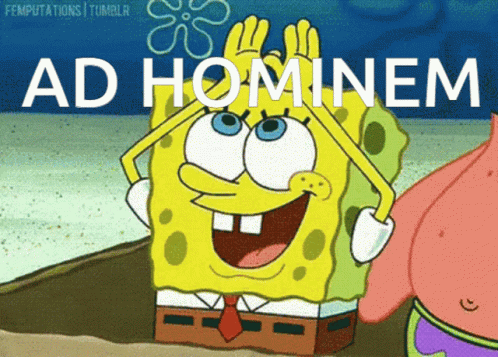
Jim turns this into an ad hominem and deflects and ignores the question by distracting his readers with the ad hominem.
In the previous box answer, Jim answers honestly by admitting that there were 100% Masonic rituals in the revealed and restored endowment ceremony from the beginning, which were removed by the LDS Church's leadership in 1990.
Elsewhere, Jim concedes that Freemasonry originates in medieval Europe and is not ancient or of divine origins.
Unfortunately, Jim refuses to explore this problem further and answer why these 100% pagan (man-made/non-divine/non-religious) Masonic rituals were even present in the restored and revealed endowment ceremony to begin with.
Joseph's "are not to be altered or changed"
What does it say about the Church if it removed something that Joseph Smith said he restored and which would never again be taken away from the earth?
Joseph Smith said that penalties and the 5 Points of Fellowship would never be taken from the earth? When? Perhaps you’re referring to the sealing power, the keys of the priesthood, and the spirit of Elijah, all of which are still very much a part of temple worship.
Jeremy's Response
Jim isn't answering the question and is attempting to deflect from the actual question and the actual problems through strawman after strawman.
"Joseph Smith said that penalties and the 5 Points of Fellowship would never be taken from the earth? When?"
I like how Jim creates a strawman by turning this into just about the penalties and the 5 Points of Fellowship.
The answer is yes, Jim. Joseph Smith said that the ordinances (which the LDS Temple endowment ceremony is a part of) are not to be altered or changed. He said this in June 1843:
"The Prophet Joseph Smith taught, 'Ordinances instituted in the heavens before the foundation of the world, in the priesthood, for the salvation of men, are not to be altered or changed.'" – Ensign, August 2001, p.22
Here's a screenshot from the August 2001 Ensign:

What does "ordinance" mean? The LDS Church's own definition: "Sacred rites and ceremonies."
I'm referring to the whole enchilada, Jim, that is the Temple LDS ceremony that Joseph said he restored and which is not to be altered or changed.
Is God really going to require handshakes?
Is God really going to require individuals to know secret tokens, handshakes, and signs to get into heaven?
Yes, which is why God is going to provide that information to every person who has ever lived or ever will live by means of proxy temple ordinances. The temple is extraordinarily inclusive in a way that no other religious tradition can match.
Jeremy's Response
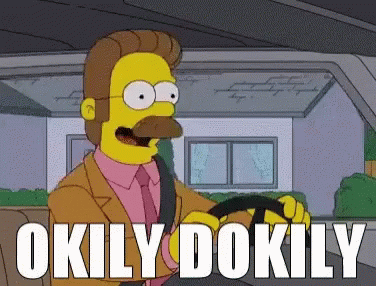
See God knows us personally...why handshakes?
What's the purpose of the handshakes?
What is the purpose of them?
To establish a covenantal relationship with the whole human family that will “turn the heart of the fathers to the children, and the heart of the children to their fathers’ (Malachi 4:6) and bind together every person who has ever lived. A magnificent purpose, I’d say.
Jeremy's Response
This is Jim's Jim Bennett Mormonism® opinion.
Here's the Prophet Brigham Young contradicting Jim and his Jim Bennett Mormonism®:
"Let me give you a definition in brief. Your endowment is, to receive all those ordinances in the house of the Lord, which are necessary for you, after you have departed this life, to enable you to walk back to the presence of the Father, passing the angels who stand as sentinels, being enabled to give them the key words, the signs and tokens, pertaining to the holy Priesthood, and gain your eternal exaltation in spite of earth and hell."
God knows us personally...why handshakes?
He does, and they are. What does that have to do with temples?
Jeremy's Response
Here's the paragraph and context that I use the above sentence in that answers Jim's question:
Is God really going to require individuals to know secret tokens, handshakes, and signs to get into heaven? What is the purpose of them? Doesn’t Heavenly Father know our names and know us personally? Indeed, aren’t the very hairs on our heads numbered? And couldn’t those who have left the Church and still know of the secret tokens, handshakes, and signs (or those who have watched the endowment ceremony on YouTube) benefit from that knowledge?
As Brigham Young taught, we need the "key words, the signs and tokens" to "enable [us] to walk back to the presence of the Father" and "gain [our] eternal exaltation". As mentioned here, Jim agrees that these tokens, handshakes and signs are required to get into heaven.
When my daughter was little, she loved to play a game where she would block the stairs and you had to give her the secret code in order to pass and gain access to the upstairs area of the house.
While cute and funny with a kid...it seems extremely juvenile and silly for a God to require secret codes in order to get upstairs. If Heavenly Father knows our names and us personally? If he numbers the hairs on our heads? Why does he need our silly handshakes and codes to get in?
Further, anyone (Post Mormons and Never Mormons) know or can access these "secret" tokens, handshakes and signs from YouTube now which makes the whole enterprise even sillier and absurd.

It would be like coming back home to my dad and when he opens the door, I have to do all of these weird handshakes, tokens and signs with him in order to enter the house. If God is anything like a good father who knows who his kid is - like my dad? He'd give me a WTF look, a laugh, a hug and would tell me to just get my ass in the house. No 5 Five Points of Fellowship or strange handshakes needed for him to know I'm his kid that he loves unconditionally and my worth and value to him is immutable.
This whole enterprise of secret handshakes, tokens and signs to please and access a God who knows us personally and who numbers the hairs on our heads just seems so Masonic and...ridiculous.
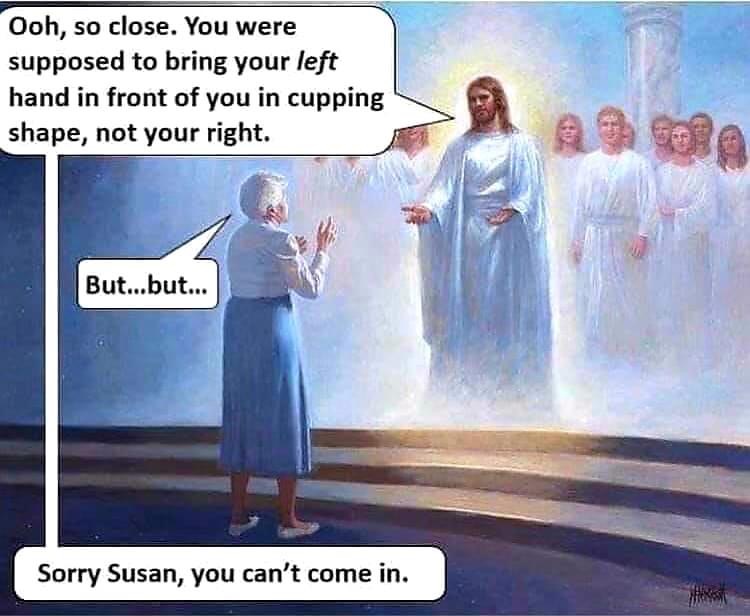
Handshakes on YouTube
And couldn’t those who have left the Church and still know of the secret tokens, handshakes, and signs (or those who have watched the endowment ceremony on YouTube) benefit from that knowledge?
The covenants are the issue, not the physical mechanics of the covenants. Those mechanics aren’t likely to be helpful to those who either violate their covenants or never made the covenants in the first place. At the same time, every member of the human family will have the opportunity to make these covenants for themselves, so YouTube is superfluous.
Jeremy's Response
This is Jim's Jim Bennett Mormonism® contradictory and unsupported opinion.
Here's the Prophet Brigham Young contradicting Jim and his Jim Bennett Mormonism®:
"Let me give you a definition in brief. Your endowment is, to receive all those ordinances in the house of the Lord, which are necessary for you, after you have departed this life, to enable you to walk back to the presence of the Father, passing the angels who stand as sentinels, being enabled to give them the key words, the signs and tokens, pertaining to the holy Priesthood, and gain your eternal exaltation in spite of earth and hell."
Eternal salvation depends on Masonic rituals?
Does the eternal salvation, eternal happiness, and eternal families really depend on Masonic rituals in multi-million dollar castles?
"Does the eternal salvation, eternal happiness, and eternal sealings of families really depend on medieval originated Masonic rituals in multi-million dollar castles?"
Earlier, you admitted that the endowment ceremony has significantly departed from Masonry, and now you call the endowment nothing more than “medieval originated Masonic rituals.”
Which is it? Make up your mind.
Eternal salvation, eternal happiness, and eternal sealings depend on the Atonement of the Lord Jesus Christ. The rituals are symbols that connect us to God, but it is God that saves, not the rituals.
Jeremy's Response
No, Jim. I did not "admit that the endowment ceremony has significantly departed from Masonry". You either misunderstand what I wrote or you're deliberately misrepresenting what I wrote. See "Restored" endowment looks more like apostatized Masonry.
I simply point out how earlier Mormons like Heber C. Kimball and even Elder Ballard's grandfather believed that the endowment was a restoration of a truer or purer form of Freemasonry and I ask why the LDS Endowment is a reflection of 19th-century Illinois Freemasonry instead.
Finally, Jim inserts his Jim Bennett Mormonism® opinion that the Temple just "connects us to God" while watering it down as basically optional when the Church of Jesus Christ of Latter-day Saints says otherwise:
"Sacred ordinances and covenants available in holy temples make it possible for individuals to return to the presence of God."
- Temple Ordinances and Covenants
"Let me give you a definition in brief. Your endowment is, to receive all those ordinances in the house of the Lord, which are necessary for you, after you have departed this life, to enable you to walk back to the presence of the Father, passing the angels who stand as sentinels, being enabled to give them the key words, the signs and tokens, pertaining to the holy Priesthood, and gain your eternal exaltation in spite of earth and hell."
- Prophet Brigham Young regarding Temple endowment
Uncomfortable with Masonry and polygamous heaven
Is God really going to separate good couples and their children who love one another and who want to be together in the next life because they object to uncomfortable and strange Masonic Temple rituals and a polygamous heaven?
No one is going to be forced to live polygamously, so a “polygamous heaven” isn’t a helpful description. As for God separating couples and families, why should he? All those couples and children will have these rituals performed on their behalf, so there will be no need to separate them. The temple doctrine of redemption of the dead are extraordinarily inclusive and know of no parallel in the wider Christian world. But it’s nice that you got another dig in there about polygamy instead of one more mention of the rock in the hat.
Jeremy's Response
I didn't say anything about "force", Jim. That's your strawman.
The Mormon heaven is a polygamous heaven. Period. To deny this is to deny Mormon doctrine and the reality on the ground. It's to deny the reality that is obvious still today in 2021 where the Prophet (Russell Nelson) himself is a spiritual polygamist who is sealed to two different women. Ditto for next-in-line prophet Dallin Oaks who likewise is a spiritual polygamist sealed to two different women.
In order to get into the Celestial Kingdom, you have to go through the Mormon temple (unless you've died before the age of 8). There are people who object to polygamy and naturally Mormonism and thus will not go through the Mormon temple. These people are going to be separated from family and friends who may decide to go through a Mormon temple. They're going to be separated in the afterlife because they object to polygamy and Mormonism, which still practices it spiritually today even at the highest levels of the church.
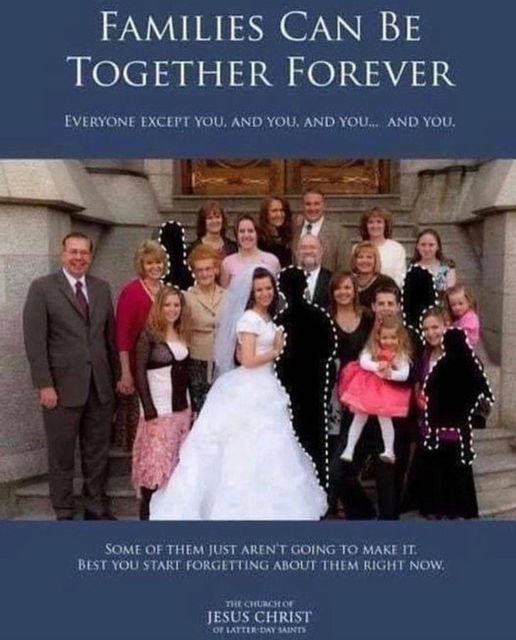
@exmormonmindy
Five Points of Fellowship
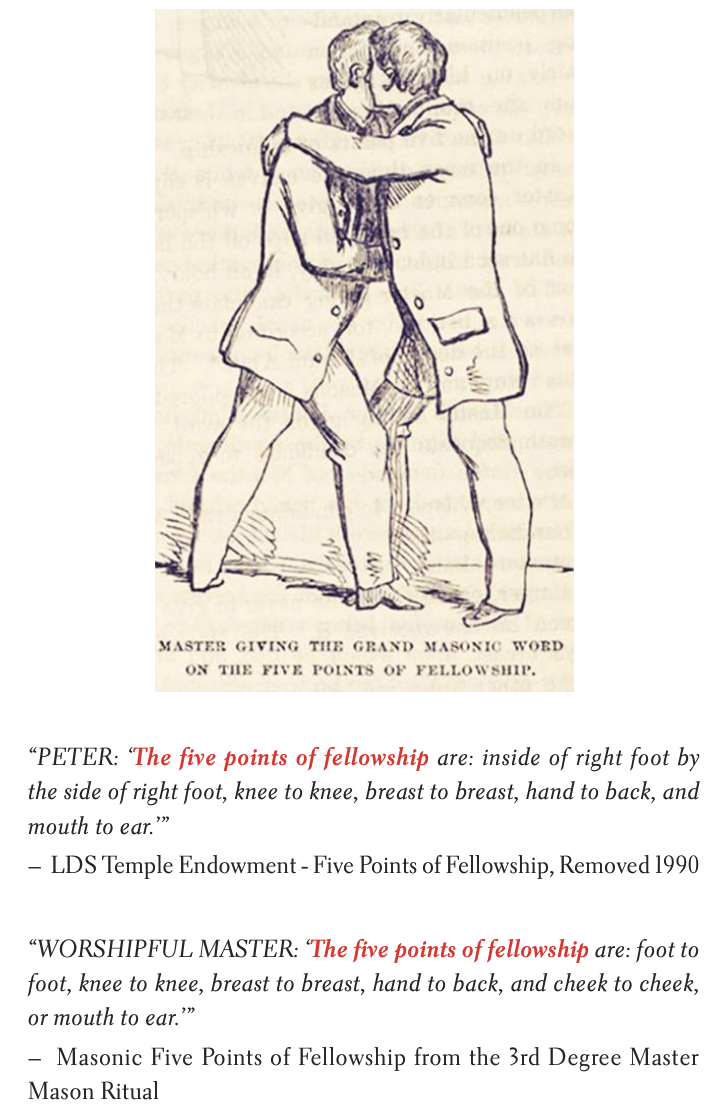
You’ve added a graphic showing the Five Points of Fellowship that I chose not to include in this reply, as I think many would see it as disrespectful to both Latter-day Saints and to Freemasons. It is quite true that this was a ritual element in Latter-day Saint temple worship until 1990, just as it’s true that it is no longer used or relevant. Instead, here’s a sphinx from outside the Masonic Temple in Salt Lake City, which is cool-looking.

Jeremy's Response
How is this disrespectful when it's "no longer used or relevant" (Jim's words)?
Jim acknowledges that the Five Points of Fellowship was at one point of time a ritual element used by both the Latter-day Saints and the Freemasons in their ceremonies.
Jim also acknowledges that this sacred element of the LDS endowment ceremony was used in the ceremony until 1990 when the LDS Church removed this sacred element out of the Temple Endowment ceremony.
Finally (and most importantly), Jim concedes that the Five Points of Fellowship and the penalties that were once sacred in the ceremony but which were ripped out by the LDS Church in 1990 are 100% Masonic ritual elements that were unnecessary.
@dereleiksucks
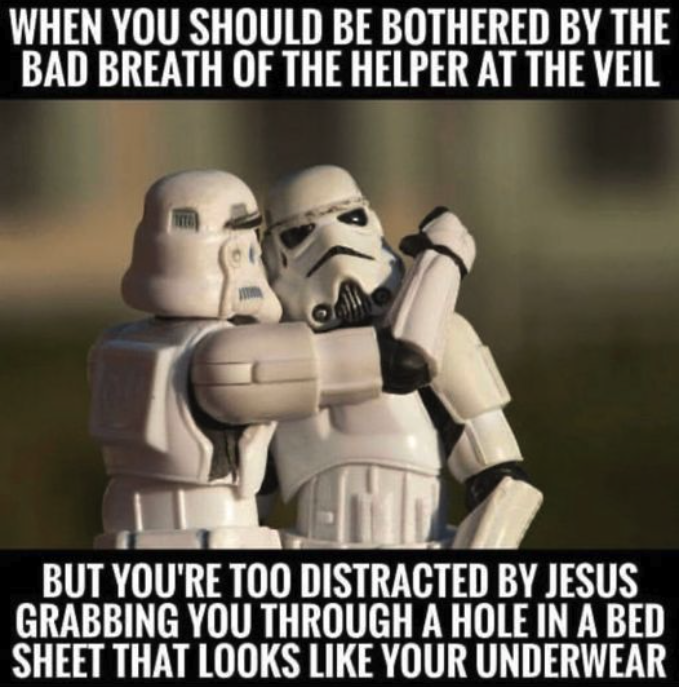
This is such a massive project that is consuming so much of our time. If you've benefited and received value from this rebuttal so far and would like to see us finish everything, please consider paying it forward with a tax-deductible donation. Anything and everything helps.
Donations of $75 or more will receive an autographed (with note of appreciation) CES Letter paperback book from Jeremy Runnells personally. Please email [email protected] confirming donation, address and autograph requests.
